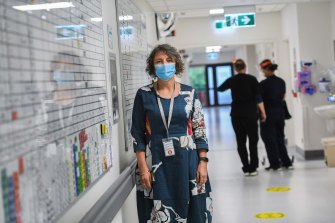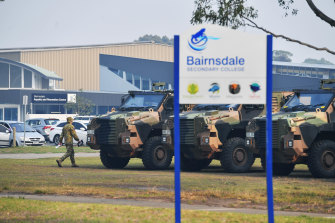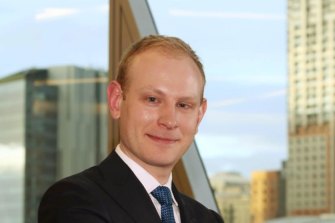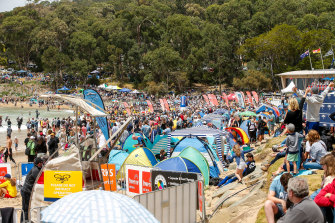Bairnsdale hospital weathers fires, cyber attacks and COVID
Since taking over as chief executive of the Bairnsdale Regional Health Service in 2018, Robyn Hayles has led a team in a near-permanent state of crisis.
A run of bushfires, cyber attacks and now COVID-19 has placed unprecedented pressure on the health service, including its hospital which has a busy emergency department.
Bairnsdale Regional Health Service chief executive Robyn Hayles. Credit:Joe Armao
The successive waves of challenges has left staff exhausted and now Bairnsdale and other regional health services face another hurdle as they struggle to plug major workforce shortages while preparing for the summer holiday rush.
“The impact on our staff has definitely been a chronic fatigue,” Ms Hayles said. “We have got some extreme workforce gaps and challenges.”
The Bairnsdale hospital has a shortfall of 892 medical shifts between December and January – the most dire shortage Ms Hayles has seen in her time in the role.
It was targeted in a cyber attack in October 2019 that temporarily shut down booking systems for regional health services across the state.
Defence force personnel setting up in Bairnsdale during the Black Summer fires. Credit:Joe Armao
It emerged from that crisis and ran almost straight into the Black Summer bushfires when many staff members feared they might lose their homes.
And then COVID struck. Last month, the hospital had to furlough staff for the first time after an asymptomatic patient later tested positive. But testing and administering vaccines has put onerous demands on the health service’s small workforce, which has delivered 17,000 vaccinations.
“It means at various times we haven’t run our other services to full capacity, including theatre and dental services,” Ms Hayles said.
On Saturday, there were 122 active COVID-19 cases in East Gippsland, including 10 new infections in the previous 24 hours.
The hospital also lies near the Mitchell River, which emergency services are watching nervously with the La Nina weather pattern raising the risk of floods over the coming summer.
Although the hospital has rolled out wellbeing programs for staff, including mindfulness and trauma training, burnout is an ever-present threat.
“My biggest concern at the moment is post-traumatic risk for our staff,” Ms Hayles said. “Because we all know that prolonged and ongoing trauma is a risk factor for people to experience post-traumatic stress.”
Ms Hayles, who sits on the board of the Victorian Healthcare Association, said beyond the emotional toll on staff, the fires exposed the shortcomings in the Bairnsdale Hospital’s physical infrastructure when smoke infiltrated the wards.
She said bushfires and the coronavirus pandemic were highlighting the need for better ventilation at hospitals.
“Small older buildings like this just don’t have that infrastructure,” she said. “I hope the way we construct buildings in the future accommodates all the things we’ve learned.”
In August this year, figures from the Australian Bureau of Statistics showed that 22,651 people from Melbourne moved into other parts of Victoria since the start of the pandemic.
Ms Hayles said it was crucial the state government helped regional health services attract more doctors and nurses while also committing to infrastructure upgrades, particularly with more people from Melbourne moving to regional Victoria during the pandemic.
Victorian Healthcare Association chief executive Tom Symondson said the exodus from the city was putting greater pressure on regional health services.
Victorian Healthcare Association chief executive Tom Symondson
“We’ve got services that weren’t designed for that. The pressure will grow,” he said.
The state government did not respond to repeated requests for comment.
Mr Symondson said many hospitals, including Bairnsdale, had been in crisis well before the pandemic struck.
He said country hospitals across the state were already struggling to fill shifts when the federal government slammed shut the international borders, denying them a crucial source of foreign labour.
“For so many parts of our state they were already in strife before COVID-19 even hit us and therefore were never given the opportunity to recover,” he said.
Mr Symondson called for greater encouragement for qualified foreign workers to take up jobs in regional Victoria.
Great Ocean Road Health chief executive Sandy Chamberlain said workforce shortages were also a major problem for her service, which has sites in Lorne and Apollo Bay, with staff diverted for coronavirus swabbing duties and administering vaccines.
She said summer would be particularly busy on the Surf Coast with Lorne’s population swelling dramatically between Boxing Day and Australia Day.
The health service is also vulnerable to bushfires with the 2015/16 blaze that engulfed nearby Wye River coming perilously close to the Lorne Community Hospital.
Summer crowds in Lorne put substantial pressure on the local hospital every summer. Credit:Mark Dadswell
But for now, it is solely focused on getting through the coming months.
“We’re expecting it to be our busiest summer, and we won’t have the staff we’ve had in previous years to provide additional care,” Ms Chamberlain said.
The Morning Edition newsletter is our guide to the day’s most important and interesting stories, analysis and insights. Sign up here.
Most Viewed in National
From our partners
Source: Read Full Article



